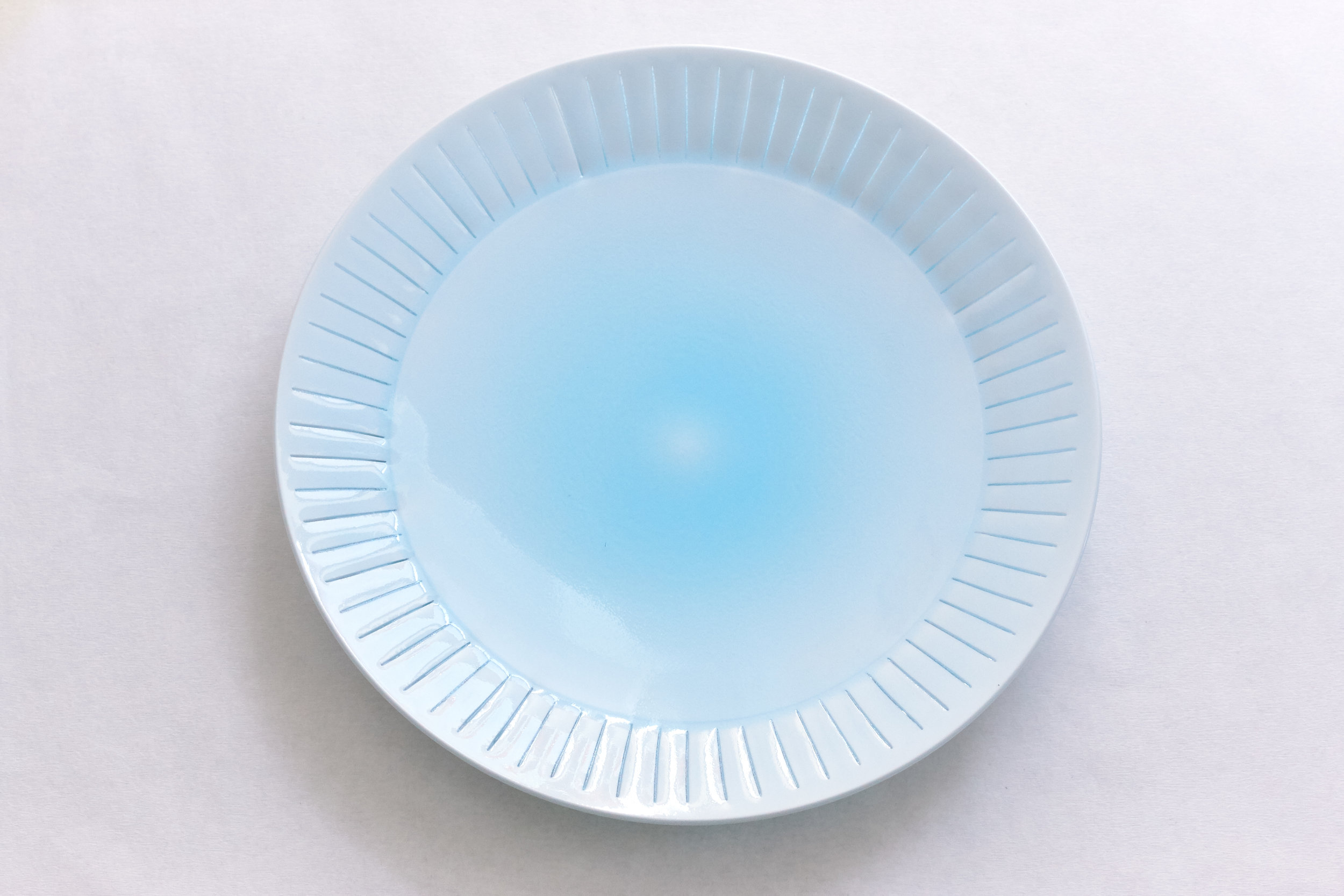 Image 1 of 7
Image 1 of 7

 Image 2 of 7
Image 2 of 7

 Image 3 of 7
Image 3 of 7

 Image 4 of 7
Image 4 of 7

 Image 5 of 7
Image 5 of 7

 Image 6 of 7
Image 6 of 7

 Image 7 of 7
Image 7 of 7








Flower of Water Plate by Kotaro Ikura
Kotaro Ikura, an award-winning ceramic artist from Nara, brings forth the Flower of Water Plate, a masterful expression of fluidity and light. Crafted using the ancient Hotarude technique, the translucent porcelain reveals delicate, glowing patterns under light—an effect reminiscent of shimmering water. The soft blue hue enhances its ethereal quality, making each plate a functional yet mesmerizing work of art. Handmade with precision, every piece is unique, carrying the serene essence of nature’s quiet beauty.
Medium: approx. 240mm D x 32mm H (9.4” D x 1.25” H)
KO05
Large: approx. 270mm D x 35mm H (10.6” D x 1.4” H)
KO06 - currently unavailable
These are all made by hand, so each one may differ from the photo and listed measurements.
Kotaro Ikura, an award-winning ceramic artist from Nara, brings forth the Flower of Water Plate, a masterful expression of fluidity and light. Crafted using the ancient Hotarude technique, the translucent porcelain reveals delicate, glowing patterns under light—an effect reminiscent of shimmering water. The soft blue hue enhances its ethereal quality, making each plate a functional yet mesmerizing work of art. Handmade with precision, every piece is unique, carrying the serene essence of nature’s quiet beauty.
Medium: approx. 240mm D x 32mm H (9.4” D x 1.25” H)
KO05
Large: approx. 270mm D x 35mm H (10.6” D x 1.4” H)
KO06 - currently unavailable
These are all made by hand, so each one may differ from the photo and listed measurements.
Kotaro Ikura, an award-winning ceramic artist from Nara, brings forth the Flower of Water Plate, a masterful expression of fluidity and light. Crafted using the ancient Hotarude technique, the translucent porcelain reveals delicate, glowing patterns under light—an effect reminiscent of shimmering water. The soft blue hue enhances its ethereal quality, making each plate a functional yet mesmerizing work of art. Handmade with precision, every piece is unique, carrying the serene essence of nature’s quiet beauty.
Medium: approx. 240mm D x 32mm H (9.4” D x 1.25” H)
KO05
Large: approx. 270mm D x 35mm H (10.6” D x 1.4” H)
KO06 - currently unavailable
These are all made by hand, so each one may differ from the photo and listed measurements.
KOTARO IKURA
The Flower of the Water.
Imagine a delicate pale blue and white flower floating on the water, see how the light plays and dances on it. Take a few steps and look at it from a different angle, appreciate how the view and beauty changes.
Holding and looking at these quietly stunning ceramic works from Kotaro Ikura conjures similar visions and thoughts.
Ikura was born into a ceramics family, the first son of a fourth generation Yagyu Yaki (ceramics artisan) in the ancient town of Nara, the original capital of Japan, near Kyoto. His path was to take over the family business, being the son of a famous potter. As a young boy, he was fascinated by his father’s working, standing by his side for hours as he threw pottery, but he wasn’t allowed to do it himself. So, his interest waned over time — preferring, as most kids do, to run and play with friends.
After high school, he wasn’t sure what to do, so he went to Osaka Art University, figuring that he would eventually end up helping his father and ultimately take over the business. However, when he was finally able to touch the wheel there, he was transformed. From his observations of his father when he was young, he had a bit of a head start and much of the work came naturally. When he returned home after school, he dove into his passion — porcelain, which is a completely different technique and was not part of the family business.
With his skill in pottery, it might have been easier for him to follow his father’s footsteps as a master potter, but he was determined to delve into his love of porcelain. His attempts the first few years, as is often the case, weren’t to his liking, but he kept at it and persevered — eventually winning several prestigious awards. Ikura-san’s father watched as his son struggled, but the elder Ikura never criticized.
In 2009, he made the decision to go independent.
Ikura started by creating “blue white” porcelain — a delicate light blue porcelain that originated many centuries ago in China. The blue is a result of a small amount of iron that tends to pool in the bottom of a vessel in subtle gradations, giving it the fleeting appearance of water that seems to move.
Becoming comfortable with this technique, Ikura wanted to take it further. So he decided on creating new pieces using an ancient technique called Hotarude (蛍手) — a traditional method of Chinese and Japanese pottery that is created by making small holes or carvings on the surface, and then covering them with a thin glaze to make the beautiful transparent patterns you see in his plates.
He calls this series "mizu no hana" (水ノ華), meaning "flower of the water" — the name was coined when he showed his first Hotarude efforts to some fellow ceramists who he respected.
Ikura's father, Toshio, passed away recently. Reflecting back, he knows his decisions caused his father to worry about him with the love of a parent. “After his passing” he says, ”I often wonder if he lived his life for me. Because of him, I could focus on my work comfortably.”
We are proud to present the creations that are interwoven with his vision and his family relationship.
今でもそうですが、もっと僕の青白磁釉の透明感を解りやすく表現できないか?と試行錯誤しながら制作しています。お客様には良く見ていただくと僕の青白磁の美しさをわかっていただけるのですが、なかなか気付いてもらえない事も多かったからです。僕のオリジナル調整の磁器土に青白磁釉で焼きあげれば、シンプルな形の器でも美しく、いや、シンプルな形だからこそ釉薬と土の美しさが際立って良いのですが、その美しい青白磁にもっと日の目を当てたいと言う思いから、インパクトがあってパッと見でも人を惹きつける何かが欲しいと思っていた時に、新里明士さんの蛍手の作品を見てヒントをいただき制作しました。蛍手なら青白磁釉をもっと全面に押し出してアピールできると思ったからです。
そして、より釉薬だけの面積を増やしたいが為に、線状に穴を開けて釉薬を埋め込む蛍手に発展していきました。初めて水の華の器が完成した時は、器の透明感、瑞々しさに、かなりの手応えを感じました。そして、僕の尊敬する先輩にその器を見てもらったところ。「水の華みたいな器やな〜。」って、とても素敵な感想をいただけて、嬉しくてそのまま、このシリーズの器を「水の華」とする事にしました。
土の事ですが、僕が使っている磁器土はオリジナル調整しています。主成分?主な土は、天草陶石という、九州の磁器土とニュージーランドカオリンというニュージーランドの土を混ぜてあります。他にもすこし、マニアックな材料を混ぜて、あの白さと青白磁釉の高温焼成に耐えられる磁器土に調整しております。青白磁釉もオリジナル調整です。
普通、青白磁釉を調整する時は鉄分を数パーセント足して青味を出すのですが(鉄分を増やせば増やすほど、色は変化していきます。還元焼成の場合、水色→緑色→黄色→茶色→黒)、僕の青白磁は磁器土がかなり白いので、鉄分を足さなくても、釉薬の原材料の中にもともと入っている僅かな鉄分が発色する青味でも、青白磁になる訳です。ただし、普通より淡い青味ですので、そのぶん釉薬をかける時は普通よりかなり厚く施釉します。





